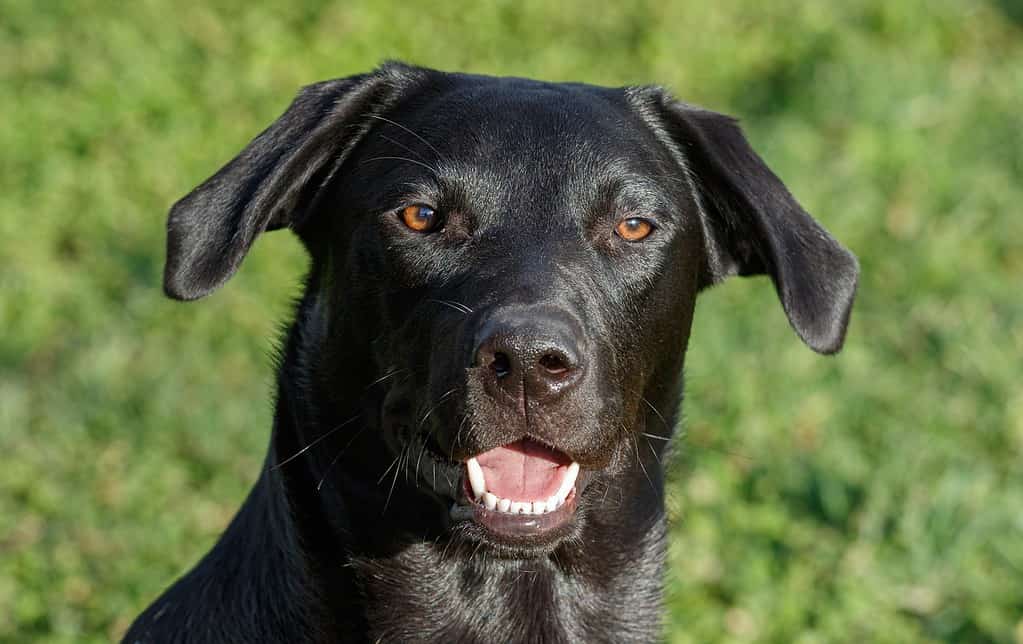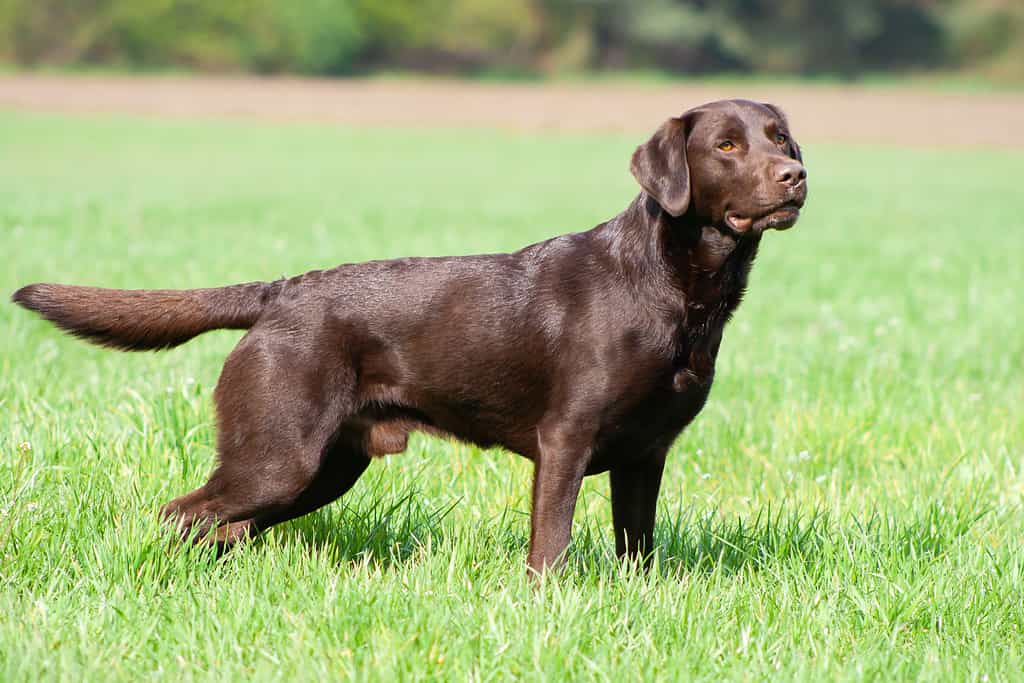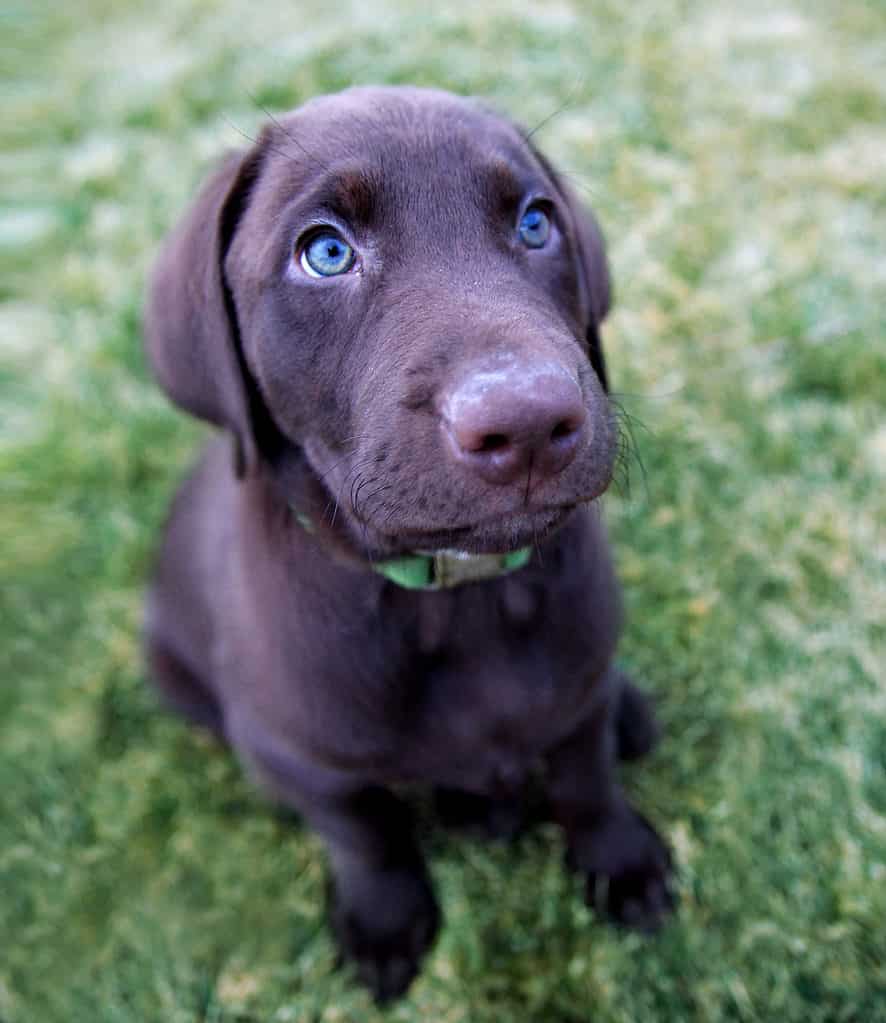The Labrador retriever, affectionately known as the “Lab,” is one of the most popular dog breeds worldwide.
Originating from Newfoundland, Canada, in the 1800s, these intelligent, friendly, and versatile dogs have won the hearts of many with their adorable appearance and lovable personalities.
While there’s only one official breed of Labrador Retriever, there are variations in the breed based on their physical features and origins. These variations are often referred to as types, and they can have different temperaments and abilities.
In this article, we will explore the seven cutest Labrador retriever breeds in the world, their characteristics, temperament, and their history.
#1 American Labrador Retrievers

With slimmer faces than their English counterparts, American Labradors have a distinct appearance.
©sanjagrujic/Shutterstock.com
American Labrador retrievers are one of the most popular types of Labrador retrievers.
American Labradors have a distinct appearance and temperament that sets them apart from other types.
Physical Characteristics
American Labradors have a lean, athletic build, with longer legs and a narrower head than other types.
They have a short, dense coat that comes in a variety of colors, including:
- Black
- Chocolate
- Yellow
They’re usually taller and slimmer than other types of Labradors. Males typically weigh 65-80 pounds, and females usually about 55-70 pounds.
Temperament
American Labradors have high energy and drive, making them great working dogs.
They’re friendly, outgoing, and eager to please, which makes them excellent family pets as well.
They are highly trainable and excel in obedience and agility competitions.
They also have strong retrieving instincts, which can sometimes make them stubborn when it comes to giving up a toy or object.
History
American Labradors were originally bred in the United States from dogs imported from England.
They were developed to be hunting dogs, and they were used to retrieve game birds and waterfowl.
They were first recognized as a distinct type of Labrador Retriever by the American Kennel Club in 1917.
#2 English Labrador Retrievers

The English Labrador retriever is a shorter and heavier variant of American Labradors.
©Judal/Shutterstock.com
English Labrador retrievers have a distinct appearance and temperament that sets them apart from other types.
Physical Characteristics
English Labradors have:
- A blocky head
- A thick, dense coat
- A stocky build
They’re shorter and heavier than American Labradors. Males typically weigh 70-100 pounds. Females are usually about 55-80 pounds.
They come in a variety of colors, including:
- Black
- Chocolate
- Yellow
Temperament
English Labradors have a calm and gentle temperament, making them great family pets.
They’re loyal, affectionate, and eager to please. They get along well with children and other animals.
They have a strong retrieving instinct and enjoy playing fetch. But they are generally less energetic and more laid-back than American Labradors.
History
English Labradors were originally bred in England for hunting and retrieving. They were developed from a combination of:
- Newfoundland dogs
- St. John’s Water Dogs
- Other breeds
They were first recognized as a distinct type of Labrador retriever by the English Kennel Club in 1903.
#3 Canadian Labrador Retrievers

The Canadian Labrador retriever is also called the St. John’s water dog.
©Gordon Wheaton/Shutterstock.com
Canadian Labrador retrievers, also known as St. John’s water dogs, are one of the oldest types of Labrador retrievers.
They were originally bred in Newfoundland and Labrador, Canada, and they have a unique appearance and temperament that sets them apart from other types.
Physical Characteristics
Canadian Labradors have:
- A broad head
- A thick, waterproof coat
- A muscular build
They’re shorter and heavier than American Labradors. Males weigh between 60 and 80 pounds, with females between 50 and 70 pounds.
They come in a variety of colors, including:
- Black
- Chocolate
- Yellow
Temperament
Like English Labradors, Canadian Labradors have a calm and friendly temperament. That makes them great family pets. They’re:
- Loyal
- Affectionate
- Good-natured
They get along well with children and other animals. They have a strong retrieving instinct and are used as working dogs in search and rescue operations and as guide dogs for the blind.
History
Fishermen in Newfoundland originally bred Canadian Labradors to retrieve fish and other items from the water.
They were also used as working dogs for hunting and retrieving game birds.
They were first recognized as a distinct type of Labrador Retriever by the Canadian Kennel Club in 1945.
#4 Show Labradors

Show Labradors are purebreds specifically bred and trained for shows.
©Anna Goroshnikova/Shutterstock.com
Show Labradors are also known as English conformation Labradors. They’re popular in dog shows and competitions.
Physical Characteristics
Show Labradors have:
- A blocky head
- A thick, dense coat
- A stocky build
They are heavier and shorter than other types of Labradors. Males weigh about 75-100 pounds. Meanwhile, females are 55-75 pounds.
They come in a variety of colors, including:
- Black
- Chocolate
- Yellow
Temperament
Gentle in general, show Labradors are great family pets. They are loyal, affectionate, and eager to please.
But they may be less energetic and have a lower working drive than other types of Labradors.
They may also have a higher risk of health problems due to their breeding for appearance rather than working ability.
History
Show Labradors were first developed in England in the early 20th century when Labrador Retrievers were becoming popular in dog shows and competitions.
Breeders breed them for their appearance, with a focus on their blocky heads, thick coat, and stocky build.
But this breeding for appearance has led to some controversy, as it may result in health problems and a decrease in working ability.
#5 Working Labradors

Working Labradors are a particularly slim Labrador breed.
©Shirebrook Photography/Shutterstock.com
Working Labradors are also known as field Labradors or American field Labradors. They’re a type of Labrador retriever that has been bred for their working abilities rather than their appearance. But they still look cute.
They’re known for their:
- Athleticism
- Intelligence
- Strong retrieving instincts
They’re popular among hunters and as working dogs.
Physical Characteristics
Working Labradors have a lean, athletic build, with a narrower head and a shorter coat than other types of Labradors.
They are lighter and taller than show Labradors. Males weigh 60-80 pounds, and females are 50-70 pounds.
They come in a variety of colors, including:
- Black
- Chocolate
- Yellow
Temperament
Working Labradors are known for their:
- Energy
- Intelligence
- Strong retrieving instincts
They’re eager to please and have a high working drive, making them great hunting companions and working dogs.
They also have a friendly and affectionate temperament, making them great family pets.
History
Working Labradors were originally bred in the United States for hunting and retrieving game birds.
They were developed from a combination of English and Canadian Labradors.
Today, they are popular among hunters as working dogs in search and rescue operations and as guide dogs for the blind.
#6 Field Trial Labradors

Field trial Labradors are bred specifically for completing field trials.
©REN Photography/Shutterstock.com
Field trial Labradors are also known as American field trial Labradors. They’re a type of working Labrador that has been specifically bred and trained for field trials. Field trials are competitive events that test a dog’s hunting and retrieving abilities.
They’re known for their:
- Speed
- Agility
- Strong retrieving instincts
They’re popular among competitive dog trainers and hunters.
Physical Characteristics
Field trial Labradors have a lean, athletic build, with a narrower head and a shorter coat than show Labradors.
They’re lighter and taller than other types of Labradors. Males are 60-80 pounds, and females are 50-70 pounds. They come in a variety of colors, including:
- Black
- Chocolate
- Yellow
Temperament
Field trial Labradors are known for their:
- Energy
- Intelligence
- Strong retrieving instincts
They have a high working drive and are highly trainable, making them great for competitive dog events and hunting.
They are also friendly and affectionate, making them great family pets. But their high energy levels may require more exercise and training than other types of Labradors.
History
Field trial Labradors were developed in the United States for field trials, which are competitive events that test a dog’s hunting and retrieving abilities.
They have become popular among competitive dog trainers and hunters.
#7 Pointing Labradors

Some Labradors have been trained to point, to complement their retrieval abilities.
©RelentlessImages/Shutterstock.com
Pointing Labradors are a type of Labrador retriever that have been specifically trained to point out game birds, in addition to their retrieving abilities.
Physical Characteristics
Pointing Labradors have a lean, athletic build, with a narrower head and a shorter coat than other types of Labradors.
They are lighter and taller than show Labradors. Males typically weigh 60-80 pounds. Females are around 50-70 pounds. They come in various colors, such as:
- Yellow
- Chocolate
- Black
Temperament
Pointing Labradors are known for their:
- Energy
- Intelligence
- Strong retrieving instincts
They have a friendly and affectionate temperament, making them great family pets. But their high energy levels may require more exercise and training than other types of Labradors.
History
Pointing Labradors were developed in the United States for hunting game birds. They were bred for their:
- Athleticism
- Intelligence
- Strong retrieving instincts
They were trained to also point game birds, making them highly versatile and desirable for hunters.
Today, they are popular among hunters and competitive dog trainers who require a dog that can both retrieve and point game birds.
The Cutest Labrador Puppies

Like all puppies, Labrador pups are absolutely adorable.
©Annette Shaff/Shutterstock.com
There’s no denying that Labrador puppies are simply adorable.
With their floppy ears, expressive eyes, and chubby bodies, these little furballs instantly capture our hearts. The cuteness factor is further enhanced by their playful and inquisitive nature as they explore the world around them with boundless energy and enthusiasm.
Watching them interact with their siblings, clumsily chase after toys, or cuddle up for a nap is enough to make anyone’s heart melt.
Social Media Stars
Several Labrador puppies have gained a significant following on social media platforms like Instagram, TikTok, and YouTube. These lovable pups showcase their daily adventures, from learning new tricks and making friends at the dog park to simply napping in the sun.
Their adorable antics and heartwarming interactions with their owners and other animals have garnered thousands of likes and comments, making them some of the cutest Labradors in the world.
Adorable Rescue Stories
Some of the most endearing Labrador puppies are those who have been rescued from difficult circumstances and given a chance at a happy life. These inspiring stories often feature puppies that have been abandoned, injured, or born with disabilities.
Through the love and dedication of their rescuers and new families, these pups not only overcome adversity but also thrive, capturing the hearts of everyone who hears their stories.
Personal Anecdotes from Owners
Every Labrador puppy owner has their own tale to tell about their furry companion’s cuteness. From hilarious mishaps and quirky habits to moments of pure affection, these anecdotes perfectly capture the essence of what makes Labrador puppies so irresistible.
By sharing these personal stories, we can appreciate the unique charm and endearing qualities that make each puppy special in its own way.
Key Takeaways
Labrador Retrievers are a highly popular breed of dog known for their intelligence, loyalty, and friendly temperament. While there are many different types of Labradors, each with their own unique characteristics and qualities, all Labradors share certain traits that make them great companions and working dogs.
No matter which type of Labrador you choose, you can be sure that you are getting a loyal and affectionate companion that will bring joy and companionship to your life. With proper training and care, Labradors can be highly skilled working dogs, as well as beloved family pets.
It’s important to acknowledge that cuteness is a subjective quality, and every Labrador is special in their own way. So while we’ve curated a list of some exceptionally cute Labradors, we encourage readers to appreciate and celebrate the unique qualities of their own furry companions.
The photo featured at the top of this post is © iStock.com/Frankenvrij
Ready to discover the top 10 cutest dog breeds in the entire world?
How about the fastest dogs, the largest dogs and those that are -- quite frankly -- just the kindest dogs on the planet? Each day, AZ Animals sends out lists just like this to our thousands of email subscribers. And the best part? It's FREE. Join today by entering your email below.
Thank you for reading! Have some feedback for us? Contact the AZ Animals editorial team.






